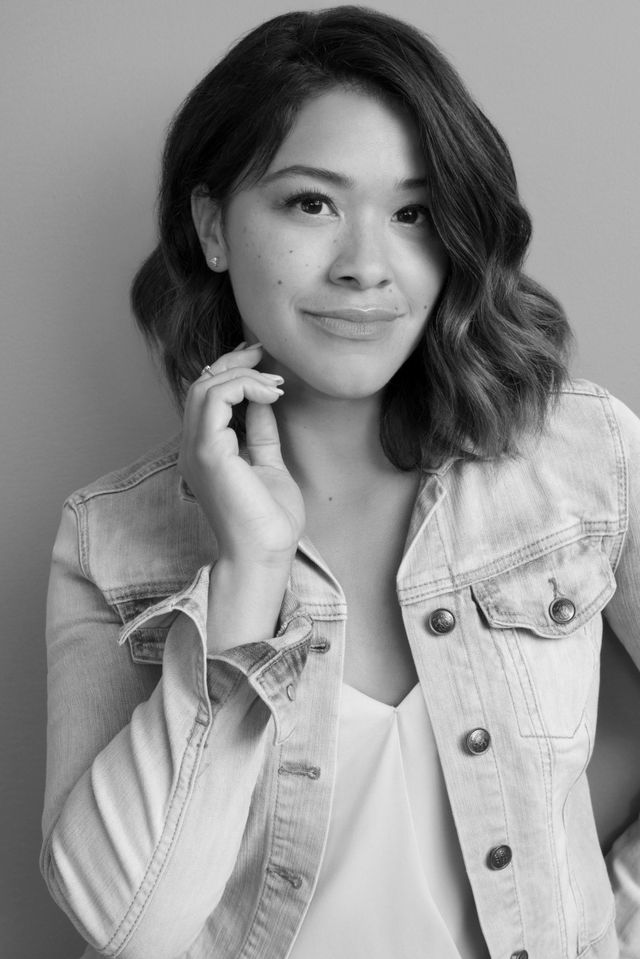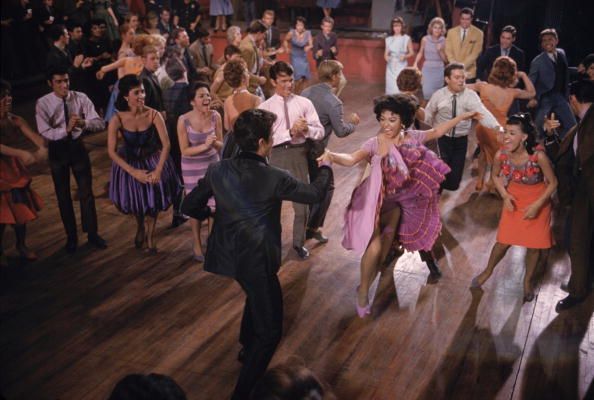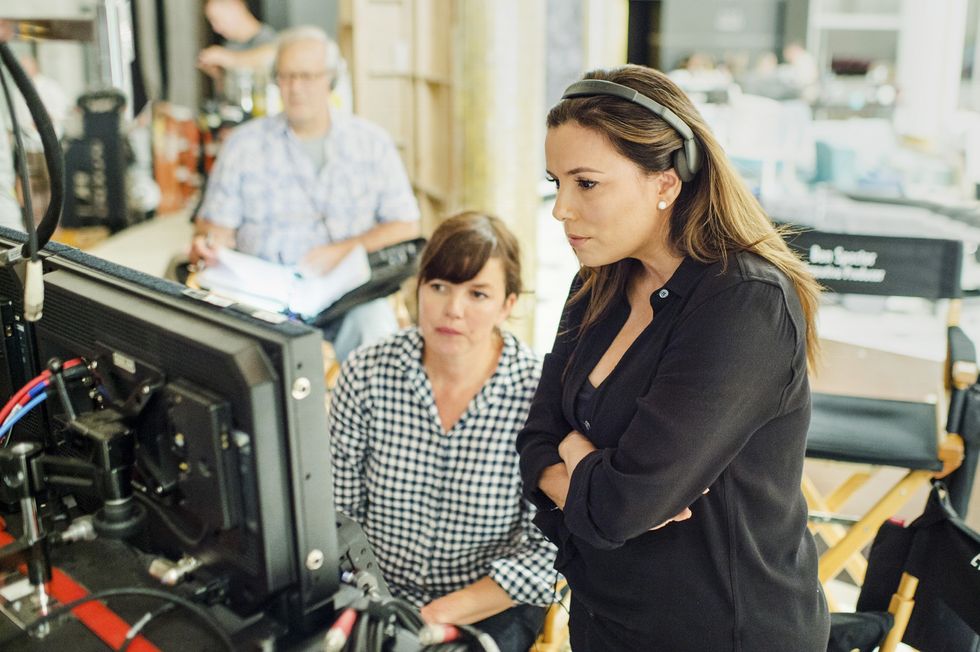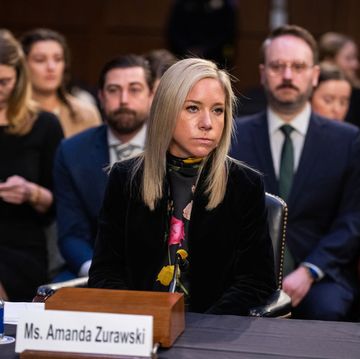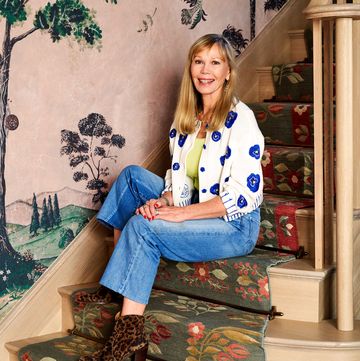In the “America” scene from the 1961 film version of West Side Story, Anita, played by Rita Moreno, sings the merits of her adopted homeland, while her costar George Chakiris (as Bernardo) makes the argument that life was better in Puerto Rico. It’s a catchy song in a crowded, colorful scene, and only the most observant viewer might notice that Chakiris is wearing brown paint on his face, or that in the balcony scene right before, Maria, played by Natalie Wood, is struggling with her accent. In fact, Moreno is the only actual Puerto Rican lead in the movie—and the first Latina ever to win an Oscar, for her portrayal of Anita. It’s too soon to tell whether Steven Spielberg’s upcoming remake of the musical about a turf war between white and Puerto Rican teenagers will right some of its predecessor’s wrongs, though the fact that Moreno signed on in late November to appear in the film and will also serve as executive producer will likely help. The recent casting of 17-year-old Rachel Zegler (who is Colombian-American) as Maria is another positive step. But what is certain is that while Hollywood has been racing to fix its diversity problem since #OscarsSoWhite, it still falls far behind when it comes to Latinx representation.
The statistics are baffling: Up to 18 percent of the U.S. population, more than 48 percent of Los Angeles County, and 24 percent of the American moviegoing public identify as Latinx (the gender-neutral term for individuals of Latin American descent), but only 6 percent of speaking roles in the top 100 movies at the box office go to Latinx characters, according to the University of Southern California’s Annenberg Inclusion Initiative. Only one Latina director, Patricia Riggen, has broken into the top 1,100 movies at the box office between 2007 and 2017. The Latinx drought in Hollywood has left millions of Americans unseen on screens for decades. There’s a glimmer of hope in the Oscar buzz over Alfonso Cuarón’s excellent Roma, and a slate of new projects with fresh faces like Rosa Salazar and Eiza González in Alita: Battle Angel, Adria Arjona in Triple Frontier, and Ana de Armas in The Informer might signal the beginning of a more inclusive era. But there’s still a lot to fix if true change is the goal.
For most of Hollywood history, Latinx actors were boxed into stereotypes like the cartoonish Mexican bandito (and, later, gang member), sultry Latin lover, or hot-tempered spitfire. “I was always very aware that there was a lack [of Latinx actors] onscreen, especially because I wanted to be an artist,” says actress Gina Rodriguez. When she watched Patricia Cardoso’s Real Women Have Curves, she immediately connected with America Ferrera’s character. When Rodriguez began searching for other Latinx faces in movies, her mother introduced her to Rita Moreno’s work. “I was like, Where is this [now]? I want more of this.”
Latinx stars have gone through booms and busts throughout U.S. history. In 1944, toward the end of the Good Neighbor Policy—President Franklin D. Roosevelt’s attempt to improve relations with Latin America through fair trade agreements and other reciprocal exchanges—Walt Disney released the film The Three Caballeros to promote better understanding of our allies to the south. The Chicano film movement blossomed alongside the indie-film heyday of the late ’80s and ’90s, which produced stories like La Bamba, Stand and Deliver, and Selena. But as studio financing for smaller films dried up, so did the opportunities for Latinx filmmakers. One sign that this latest wave of inclusivity might stick around: More Latinx individuals are moving into executive-level roles. Paving the way in this regard is Salma Hayek, whose production company Ventanarosa was behind 2002’s Frida. Hayek also served as an executive producer for Ugly Betty, which ran on ABC from 2006 to 2010. “For so long, we’ve not been able to tell our own stories; we’ve had to wait until the stories are told about [us],” says TV showrunner Tanya Saracho. Her Starz series, Vida, follows two Mexican American sisters as they return to their old neighborhood after their mother’s death. “It’s a form of erasure, because then you never have your own testimony. You never have your own narrative out there.”
Since her breakout role in 2012’s Filly Brown and her star turn in the critically acclaimed TV series Jane the Virgin, Rodriguez has channeled her passion for telling Latinx stories into her own production company, I Can and I Will. Now she’s poised to take on one of her most ambitious projects to date: starring in this month’s big-budget studio remake of Miss Bala, a 2011 Mexican film about an aspiring beauty queen caught up in the country’s drug war. In terms of representation, Miss Bala could easily boost the percentage of Latinx talent onscreen and behind the camera—95 percent of the cast and crew were Latinx, possibly for the first time in Hollywood studio history. “We were speaking English and Spanish [on set],” Rodriguez says. “There was this sense of pride and this collaborative, collective heartbeat. I think all of us were a little stunned that a major studio would let us do it.”
The problem with being the first movie to break barriers, though, is the pressure to be wildly successful at the box office. Cases in point: Black Panther and Crazy Rich Asians. If those movies had failed, others featuring mostly black or Asian casts might have stalled. Thankfully, they were among the highest-grossing films of last year. Now Miss Bala is feeling the heat. “I’m human. It is petrifying,” Rodriguez says. “But it’s what I’ve been dreaming of since I was 15 years old, and there’s no better feeling than to know that we imagined a film, a famous Mexican film, and we stuck to it. It wasn’t whitewashed.”
Both Rodriguez and director Catherine Hardwicke were drawn to Mexican writer Gareth Dunnet-Alcocer’s reimagined script. “He did a lot of research, expanded the story, and made [the lead character] a lot more active,” Hardwicke says. “I was just hooked.” Some might lament the fact that Hollywood’s big Latinx moment hinges on a project so tied to cartel stereotypes, but Hardwicke, one of the few non-Latinx crew members, went into the project with the intention of quashing outdated narratives. “We have people who are vilifying or demonizing or making our neighbor out to be something other than ourselves,” she says. “We really wanted to show the new Tijuana, which has cool old food trucks, radical modern architecture, and a lot of interesting culture.”
While the film world is slowly starting to open its doors to Latinx stars, television appears to have doubled down on its diversity efforts. In 2017, Netflix remade Norman Lear’s show One Day at a Time into a series about a working-class Cuban American family in Los Angeles, with Cuban American showrunner Gloria Calderon Kellett taking the lead alongside co-showrunner Mike Royce. Saracho’s Vida premiered last May. And this spring, actress Natalie Morales will play the title character in Abby’s, a new NBC sitcom. These shows feature prominent queer characters, strong women, and, most importantly, rarely seen sides of the Latinx experience. “When we have an administration that’s talking about our people in a negative and divisive way, it lets me know that there are people who live in parts of this country whose only knowledge of Latinos is based on what they watch on television,” Calderon Kellett says. “I have a responsibility as a storyteller to let them know that it’s not just Gangbanger Number Five who’s killing people on CSI, and it’s not just whatever fearmongering our president is doing, talking about people trying to come over from the border. There are also a ton of hardworking, legal Americans who are documented, who are trying to get jobs, who are not trying to hurt anyone.”
According to Benjamin Lopez, the executive director of the National Association of Latino Independent Producers (NALIP), when it comes to getting a foothold in the movie business, the “lack of a pipeline is keeping us 20 years behind.” The traditional route of making a short, playing a film festival, making a small-budget feature, and then getting discovered by a studio doesn’t seem to work as well for Latinx filmmakers. In some cases, they lack solid connections, or they can’t access funding, or they can’t afford to take an entry-level, low-paying internship. Organizations like NALIP can put the résumés and reels of underrepresented candidates in front of key producers and agents. For instance, NALIP connected writer Nancy C. Mejía to the Vida writers’ room. “They gave me 13 scripts, and I found her,” Saracho says. “That week, we hired her. Then I gave her an episode [to direct]. She did beautifully.”
Actress Eva Longoria, an executive producer of ABC’s Grand Hotel, says that Hollywood still has a long way to go. “When you’ve had decades of white males holding every single position, it’s definitely a little harder to break in and try somebody new,” she says. And token hires do little to effect change. “I was a diversity hire from ABC, but then it was sort of like, ‘Well, you’re in—figure it out on your own,’” Saracho says. Doors open, but there’s little championing or shepherding after the fact. “The rhetoric is that it’s the greatest thing to be a woman of color in this city, because people finally understand that there needs to be a shift in the opportunities given,” Calderon Kellett says. “People have said, ‘Oh my God, it must be great to be a Latina right now.’ I’m like, ‘Okay. Name five others.’ ” And like in most industries, women in Hollywood “have to work twice as hard and be twice as prepared,” Longoria says. “If we have one bad female director, people say, ‘Oh, female directors are horrible.’” Which is why Miss Bala has become—for better or worse—a film with something to prove and history to make. “It was a huge-budgeted, major studio film, and they said the American girl is Gina Rodriguez. Rodriguez!” says its star. “That’s the American girl. That’s revolutionary.”
This article originally appeared in the February 2019 issue of ELLE.
